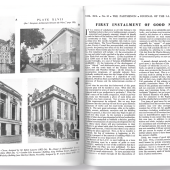Left behind

The Insulation Manufacturers Association (IMA) has fears that millions of homes that need to be upgraded for energy and heat efficiency are being forgotten about.
The consultation on the Future Homes and Buildings Standards proposals, which will establish the performance benchmarks for the coming years, closed in March. These proposals from government were disappointing, especially regarding the fabric performance of new buildings, which is likely to fall short of the requirements to achieve our 2050 net-zero targets. However, an equally pressing challenge remains: how can we address the multitude of existing buildings with poor energy efficiency? These include nearly 30 million existing homes across the social, owner-occupier and private rented sectors, many of which require substantial improvements to enhance their energy performance.
A huge challenge in the UK is that our homes are much older than elsewhere in Europe, with nearly six million houses built before 1919 and more than half built before the first insulation requirements were added to the Building Regulations in 1965. These ageing, poorly insulated homes lose substantial heat and are in varying states of repair. The sheer volume and variability of the UK’s older building stock requires tailored retrofitting approaches, not a simple one-size-fits-all solution.
With the government easing on the path to net zero and the opposition scaling back its green investment initiatives, considerable doubt should be raised on our ability to meet these challenges within the allotted timeframe.
Higher standards for energy efficiency have been introduced for new build housing – the new and updated Part L of the Building Regulations for England came into force in June 2022, followed by new energy efficiency updates in Scotland and Wales in November and December 2022 – plus the Future Homes Standard is currently under consultation. From April 2024, changes to building regulations will mean new homes and buildings (in Scotland) will not be allowed to use direct emission (or polluting) heating systems like oil and gas boilers and bioenergy. These standards are not yet good enough and more will need to be done to meet the net-zero challenge. Unfortunately, there is little happening to promote and deliver the improvements needed for existing buildings, with the Prime Minister having said: “No households will be forced to make their homes more energy efficient.”
Prior to the most recent green U-turn, the government had a vague aim of upgrading existing homes to EPC C by 2035, but only where “practical, affordable and cost effective”. It then scrapped the requirement for landlords to upgrade their properties to an EPC grade C by 2035. These contradictory statements indicate there is no real strategy in place, and it is difficult to see how the necessary improvements can be achieved.
The Heat and Building Strategy published in 2021 expands on the detail of heat in buildings, but there is little on improving energy efficiency, reducing demand or the essential policy needed to support any largescale approach to mass retrofitting.
If we are to move to a net-zero carbon country by 2050 (2045 in Scotland), it will be vital to make improvements to homes and other buildings to reduce emissions. This means installing a whole range of energy-saving measures, from better insulation and more efficient appliances to replacing fossil-fuelled boilers with low-carbon alternatives such as heat pumps.

Fabric first approach
Polyisocyanurate (PIR) and Polyurethane (PUR) insulation has an invaluable role in upgrading our poorly performing housing stock and ensuring a sustainable future. Good insulation is essential and one of the simplest and most cost-effective ways to reduce energy demand and cut CO2. The better or lower the U-values in walls, floors and roofs, the less heat that is lost, resulting in enhanced thermal performance. In turn this will help to deliver the standards required.
Highly effective and versatile, PIR and PUR insulation solutions are available in a range of forms including boards and blocks, cavity injected and composite panels, as well as spray and panel insulation. The use of PIR insulation with lambda values as low as 0.022 Wm/K means it is possible to achieve high insulation values using a much thinner layer of insulation when compared with traditional insulants.
Well-insulated buildings can also yield significant benefits for the lives of their users and occupants. The importance of thermal comfort, providing pleasant internal conditions during both the winter and summer months, is a prime example. This factor is seen to influence performance and productivity, as well as the physical and mental health of building users.
Another social benefit associated with better insulation is the reduction and potential elimination of fuel poverty. This issue is alleviated as a greater proportion of heat is retained more effectively in homes when incorporating superior fabric efficiencies. The provision of an enhanced building envelope results in a reduced overall fuel demand needed to achieve equivalent, sustained warmth over the winter months than for a building with lesser thermal performance.

Digital building passport
Yet another hurdle in raising energy efficiency standards is the absence of means to measure and demonstrate a building’s performance throughout its lifespan. Residential and commercial properties could benefit from a digital building passport. This could provide full traceability of products and services installed into a building, so that when it is bought/sold or renovated an accurate and informative log is kept.
Such a passport could contain building-related information on energy consumption/production, maintenance and building plans, and would be transferable between building owners. This digitisation could go some way to ensuring buildings are sustainable and perform to the standards intended.
Enhancing and retrofitting our ageing housing stock with high performance insulation plays a crucial role in reducing heating demand, thereby reducing demand on the grid and cutting CO2 emissions while simultaneously tackling fuel poverty and improving comfort and wellbeing. Only through such concerted efforts can we create a long-term asset, benefiting future generations while minimising environmental impact.
For more information about IMA visit insulationmanufacturers.org.uk







